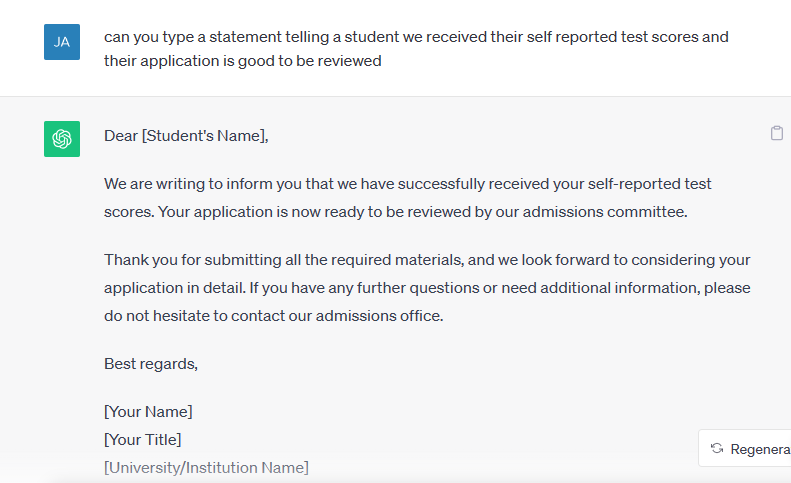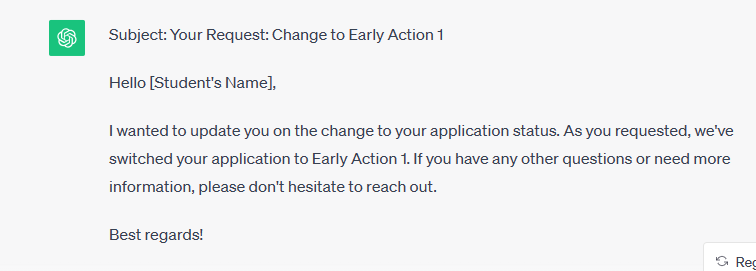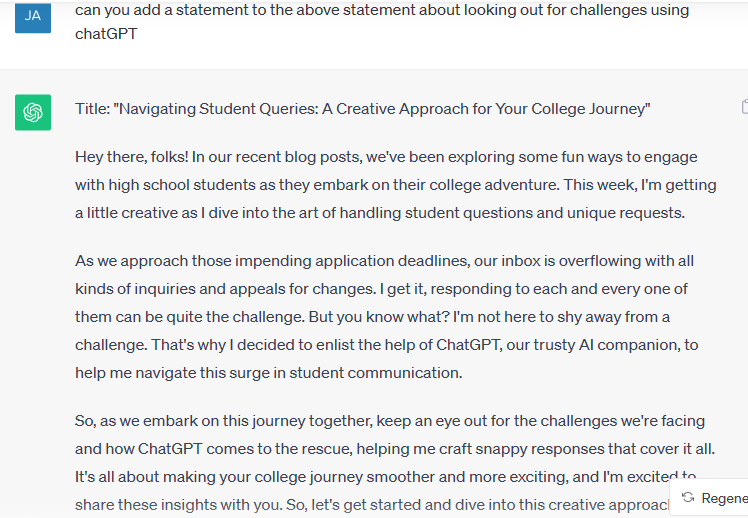
Hey there, folks! In our recent blog posts, we’ve been exploring some fun ways to engage with high school students as they embark on their college adventure. This week, I’m getting a little creative as I dive into the art of handling student questions and unique requests.
As we approach those impending application deadlines, our inbox is overflowing with all kinds of inquiries and appeals for changes. I get it, responding to each and every one of them can be quite the challenge. But you know what? I’m not here to shy away from a challenge. That’s why I decided to enlist the help of ChatGPT (Chat Generative Pre-Trained Transformer), our trusty AI companion, to help me navigate this surge in student communication.
Join me as we explore how ChatGPT can come to the rescue, helping me craft snappy responses that cover it all. It’s all about making your college journey smoother and more exciting, and I’m excited to share these insights with you. So, let’s get started and dive into this creative approach for handling your queries!
ChatGPT
This week, I have averaged about 20 emails per day. The emails contained questions about specific majors, test scores, application changes, etc. I decided to use ChatGPT to help craft confirmation and acknowledgment responses about test scores and change their application type.

Initially, I prompted ChatGPT to create a response to let a student know we received their test scores and their application is ready for review. Since I did not adjust the GPT (Generative Pre-Trained Transformer) settings from a -3.5, the original message was not what I envisioned. It took a few readjustments to get the response close enough to where I felt comfortable to submit. The issues I encountered consisted of the response being
- Written too formal
- Written in the third person
- Introductory and concluding words
After making the necessary adjustments, I was satisfied with the final result. Using ChatGPT sent me down a rabbit hole, but it was interesting to see the different edits and interpretations of my edit request. Next time, I would try to be more specific with my initial request of what I expect ChatGPT to produce. Being vague in the opening search will cause you to have to make a lot of changes that could have been resolved by being as descriptive as possible.
Pros of AI
- AI can help with producing creative activities
- Effective AI allows educators to save time with lesson/activity planning


Cons of AI
- AI is not meant to benefit every student and every learning experience.
- If you do not have a vision in mind for what your initial response could be, you will allow AI to push out a “good enough” response
- AI, ChatGPT specifically, is biased towards itself (see image)
TCE Thresholds
- Teaching is/as intellectual engagement. AI is not meant to give direct answers. For AI to be effective, those using it need to think about how we can adjust what is given to accommodate the needs of students. AI assumes you are working with the “typical student” and will produce for that student. However, any educator knows that there is no “typical student” because each student has a uniqueness, which impacts their learning.
- Curriculum is co-constructed. Working with your students to create an assignment will allow all minds to come together to adapt and change what AI produces. From what I learned about AI, it is technology and singular-focused. Allowing multiple perspectives and opinions to revamp what AI created will make for meaningful learning and understanding of why AI can not be 100% trusted.

Hi!
I’ve heard this term “down a rabbit hole” or some variation of the saying about AI many times so far in this class! It is SO TRUE. You really have to get into it to really understand it. This, I think is a huge barrier to using it. I think that often times, we want to use things that are time savers (as AI can be) but there is such a huge learning curve at the beginning that requires large amounts of time, that we just end up reverting back to the things we know because we don’t have time to learn the new tools. I think, in education, that schools should be considering this and front-loading training for us or allowing us PD time to learn these tools. Some schools let you take your own PD day to learn something, but that often requires a sub. This last week both of my kids had doctor appointments. I spent 75 minutes preparing for a sub the day before. That’s a lot of extra time – again – to prepare for a day out! So, districts need to be allotting time in PD to learn something that takes so much time – “down the rabbit hole” – to learn. It really *can* save us time, but there is also a time cost at the beginning. Time that in’t always available to some of us as teachers. I hope that districts – and universities alike – are considering this in training their employees.
I found this post on Chapt GPT PD if you’re interested!
https://www.ascd.org/blogs/planning-professional-development-on-chatgpt
Great job, JT!
You brought up something I did not think about: the ways PD can be helpful in teaching new tools to save time from going down a rabbit hole. This can be useful for veteran teachers who are not current with the new technology and may struggle to incorporate some form of AI in the classroom. I did have a moment when using ChatGPT where I felt that I could have just typed my response directly rather than spending the amount of time waiting for AI to produce the type of answer I needed.
Hi JT!
When reading your blog post, your explanation of the TCE Threshold Concept, “Teaching is an intellectual engagement” stuck out to me! You stated how AI assumes you are working with “typical students” but that as educators, we know there is no such thing. Who/What defines the word, “typical”? What does a “typical” student look like? How do they learn? I’ve always felt having a job as an educator has to be one of the most rewarding occupations as you work with youth who are figuring out who they are, are coming into their own, and are establishing their own sense of individuality right in front of your eyes. Teaching almost feels like a superpower as you have rooms full of kids from all walks of life, with all different capabilities who are waiting to hear from you to help advance their academic journeys. You’re absolutely right! We don’t work with what’s typical or traditional but we teach uniqueness and the importance of education being ever changing.
Acknowledging the privilege we have of educating the diverse students we encounter day after day and year by year is a token and honoring that is shown through active engagement and relationship building with our students. When they see that we not only pride ourselves in teaching them but also getting to know them, they feel much more safe, supported, and motivated. Being intellectually engaged in the classroom doesn’t only revolve around our courses of study but also the bodies we have in the room. Understanding who our students are (their strengths, weaknesses, interest, etc) helps us to identify and approach their needs in an effective yet meaningful way where they know they are being prioritized as both people and students, not just one or the other.
I found a blog on the importance of getting to know your students, and I think some of what you explained in your post definitely matches with what is said here: https://eatteachblog.com/importance-knowing-students/
Enjoy!
Jade,
Thank you for the comment! It is important to remove ourselves as a society from this idea of normal or typical because every person has a different sense of what these terms mean. We need to check our privileges whenever we step into a room continuously. It is necessary to not overstep in your role but to create a balance of being the supportive mentor or teacher in a person’s life.